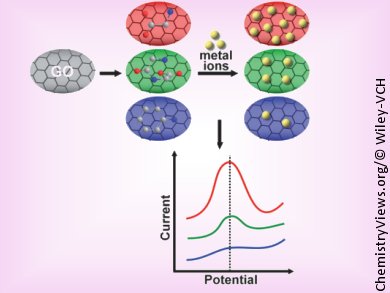Understanding the interactions of functionalized graphene is key to using its derivatives for a variety of applications in electronics and catalysis. Using an electrochemical method, researchers in China and Germany investigated the way that modification of graphene oxide influences how metal ions bind to the carbon-based support.
Linjie Zhi and co-workers, University of Shanghai for Science and Technology, China, together with collaborators at the Max Planck Institute for Polymer Research, Mainz, Germany, created different microenvironments for metal ions by modifying graphene oxide with aniline, glycine, and glycyl glycine. They then used differential pulse anodic stripping voltammetry to study the interactions between the modified graphene surfaces and the metal ions. While all three modifications enhanced the binding of Pb2+ ions, the glycine-modified surface showed the strongest interaction. The results suggest that the nitrogen atom lone pair from the modifier effectively binds metal ions to the graphene surface as long as steric hindrance remains low.
The authors comment that their findings are promising for the rational design and controllable construction of new graphene–inorganic hybrid materials.
- Exploring the Interaction between Graphene Derivatives and Metal Ions as a Key Step towards Graphene–Inorganic Nanohybrids,
Bin Wang, Qi Song, Bin Luo, Xianglong Li, Minghui Liang, Xinliang Feng, Manfred Wagner, Klaus Müllen, Linjie Zhi,
Chem. Asian J. 2012.
DOI: 10.1002/asia.201200966




